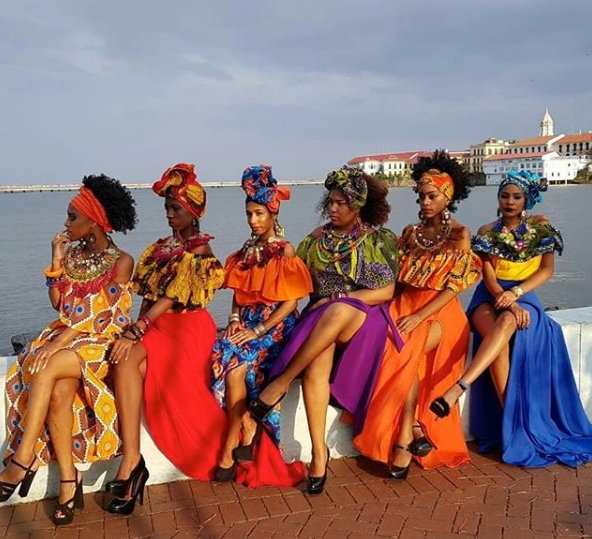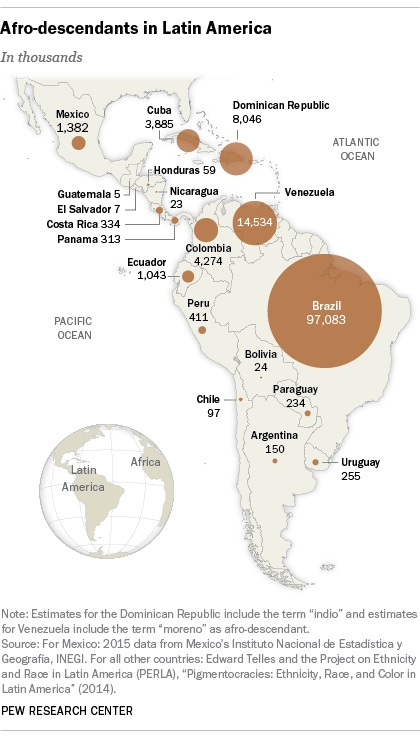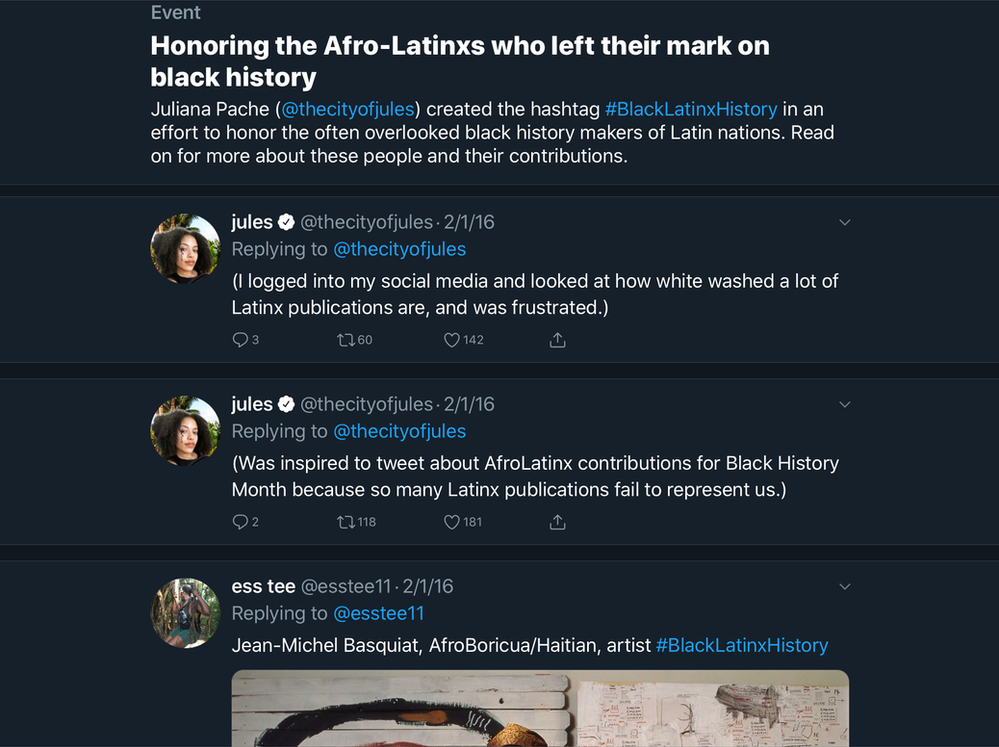National Hispanic Heritage Month begins each year on September 15 and celebrates the U.S. Latinx community, their culture and their history. The concept originated in 1968 when Congress began Hispanic Heritage Week, and expanded into a month in 1988. September 15 kicks off the anniversary of several national independence days in Latin American countries. Guatemala, Honduras, El Salvador, Nicaragua, and Costa Rica celebrate on Sept. 15, followed by Mexico on Sept. 16, Chile on Sept. 18, and Belize on Sept. 21. Identity for the U.S. Latinx community is multifaceted and multidimensional. Many tie their identity to their ancestral country of origin, and may also look to their indigenous roots. Among the many ways to see their identity, racial background is one of them.

(Photo Source: Pulso)
Afro-Latinx are one of the Latinx identity groups. Until recently, this group had not received much recognition or visibility despite having many valuable contributions throughout history. They are characterized by their diverse views of racial identity which reflects the complex nature of race and identity among the Latinx population. For the first time in U.S. history, a 2014 Pew Research Center survey directly asked the Latinx population whether they considered themselves Afro-Latino. The survey found that one-quarter of all U.S. Latinx self-identify as Afro-Latino, Afro-Caribbean, or of African descent with roots in Latin America. Latinx with Caribbean roots were more likely to identify as Afro-Latino or Afro-Caribbean than those who have origins elsewhere (34% verses 22% respectively).
The complex and varying aspects of Latinx identity is also a reflection of the long colonial history of Latin America. During colonial times there was mixing among indigenous Americans, white Europeans, slaves from Africa, and Asians. The Spanish brought a European caste system to the Americas to classify people. Illustrations from Mexico in the 1700s show classifications for individuals based on their gender, race, skin color, or place of birth. This era also gave birth to the term mestizo, or mixed race, and set the foundation for associating whiteness with power and desirability.
During Latin America’s colonial period there were about 15 times as many African slaves taken to Spanish and Portuguese colonies than there were to the U.S. The most recent count puts the population of people of African descent living in Latin America at about 130 million people, about a quarter of the total population. Until recently most Latin American countries didn’t collect official statistics on ethnicity or race, especially from those populations who had African origins. Nevertheless, a push for official recognition of minority groups throughout Latin America has led most countries to collect race and ethnicity data on their national censuses. Mexico for example, allowed people to identify as Black or Afro-Mexican for the first time in 2015 through a new question in its mid-decade survey. Approximately 1.4 million Mexicans (1.2% of the population) self-identified as Black or of African descent based on their culture, history or customs.

(Infographic by Pew Research Center)
Afro-Latinx account for large portions of the population in some regions of Latin America. Half of the population in Brazil is of African descent (either Black or mixed-race Black). Black Cubans make up about a third of Cuba’s population. In the Dominican Republic, Black identity can be a bit more complicated with estimates of Afro-descent ranging from 25% to 90%. This fluctuation depends on whether the estimates include those who identify as “indio,” a group that includes many nonwhites and mixed-race individuals with African ancestry. On the flip side, in a 2010 census 76% of Puerto Ricans identified as white although data estimated 46% had significant African heritage.
The lack of Afro-Latinx representation in history books, entertainment and media has left many Afro-Latinx feeling unseen in history and mainstream society. In 2016, Juliana Pache (@thecityofjules) created the #BlackLatinxHistory on Twitter to change the narrative and highlight Afro-Latinx figures who have had an impact on U.S. culture and beyond. In the years since, users have contributed to the thread, tweeting names of prominent Afro-Latinx people. The roots of Afro-Latinx people in the United States itself runs deep. In fact, they are responsible for establishing the country’s second largest city: Los Angeles. In 1781, 44 settlers arrived from Mexico to present day Los Angeles. According to the California Historical Society, more than half of them were Mexicans of African descent. However, their racial identity was essentially erased. According to Cecilia Rasmussen of the Los Angeles Times, for many years a plaque at the El Pueblo de Los Angeles State Historic Park honoring the “pobladores” or settlers, that indicated their race disappeared, and over 20 years later it was replaced by one that did not acknowledge it. Rasmussen wrote that according to rumor, many Recreation and Parks commissioners “had been displeased by its public display of the role Blacks played in the city’s founding.” In 1981, the year of the city’s bicentennial, it was replaced with a bronze tablet that told their names, race, sex, and age. It was installed thanks to the efforts of Miriam Matthews, California’s first college-trained Black librarian.

Anita Scott Coleman was a relatively unknown but important Afro-Latinx contributor to the Harlem Renaissance. She was a published writer who produced more than thirty short stories when the Harlem Renaissance emerged. While she never lived in Harlem, she embodied the goals of its writers. Her most famous short story was The Little House, which appeared in 1922. She published stories, essays, and poems which appeared in national magazines during the 1920s and 1930s. They emphasized racial pride and issues of importance to Black women, while also speaking out against white racism, lynching, employment discrimination, and segregation.
Another story that is often neglected is that of Afro-Puerto Rican Felicitas Mendez who helped fight segregation in schools. Seven years prior to Brown vs. Board of Education ending legal segregation in the U.S., Mendez vs. Westminister helped end segregation in California’s school districts. Felicitas, along with her husband Gonzalo, a Mexican immigrant, fought against an Orange County school in Southern California that would not allow their children to attend a “white” school in 1943. This case is widely known for ending segregation for Mexican-American children although Felicitas was Puerto Rican of African descent. While she was around many Mexicans in her community and deeply associated with Mexican culture, she always acknowledged her Puerto Rican roots.
As nuanced as Latinx identity is, unfortunately the effects of colonial views on race still affect Latinx culture today in the form of colorism as explained by MTV Decoded. In 2014, for example, model Nayara Justino entered a competition to reign as the Globeleza carnival queen. While the title had always gone to a woman of Afro-Brazilian heritage in the past, winners were traditionally light skin. Regardless, Nayara won the competition only to later be dethroned and replaced by a woman with much lighter skin. She faced great backlash from both white and Black Brazilians. When speaking about race relations in Brazil in an interview with HuffPost, Nayara said that the country has still “got a long way ahead.”
Amplifying the history and contributions of Black Latinx people in both Latin America and the United States can be instrumental in changing narratives and perspectives. Pache believes that learning about Latinx figures can help those who identify as Afro-Latinx not only broaden their sense of history, but also acknowledge the nuances of their own identity. Blackness exists in the diaspora in different places and from different backgrounds. In an interview with Bustle she said, “I feel like it would help everyone understand their own identity- not just Latinos, but Black people in general.”
Powered by WPeMatico


